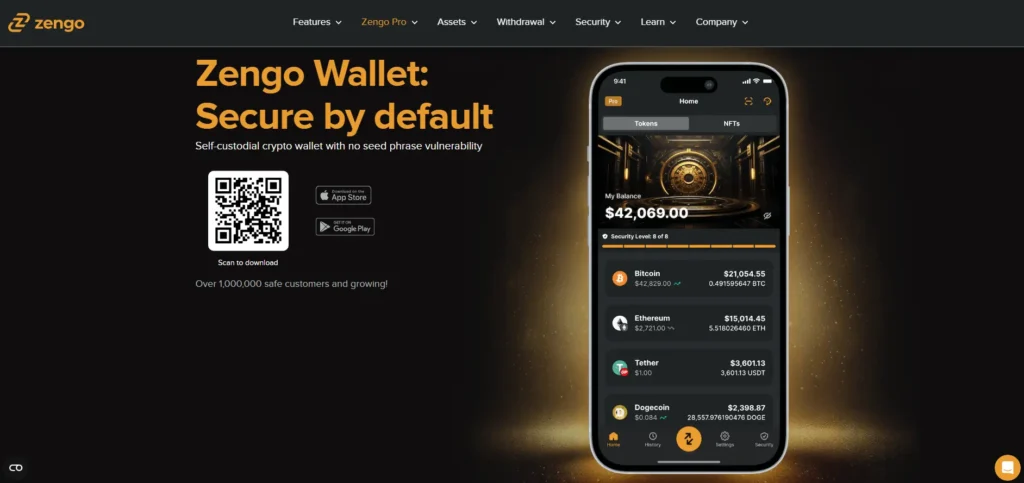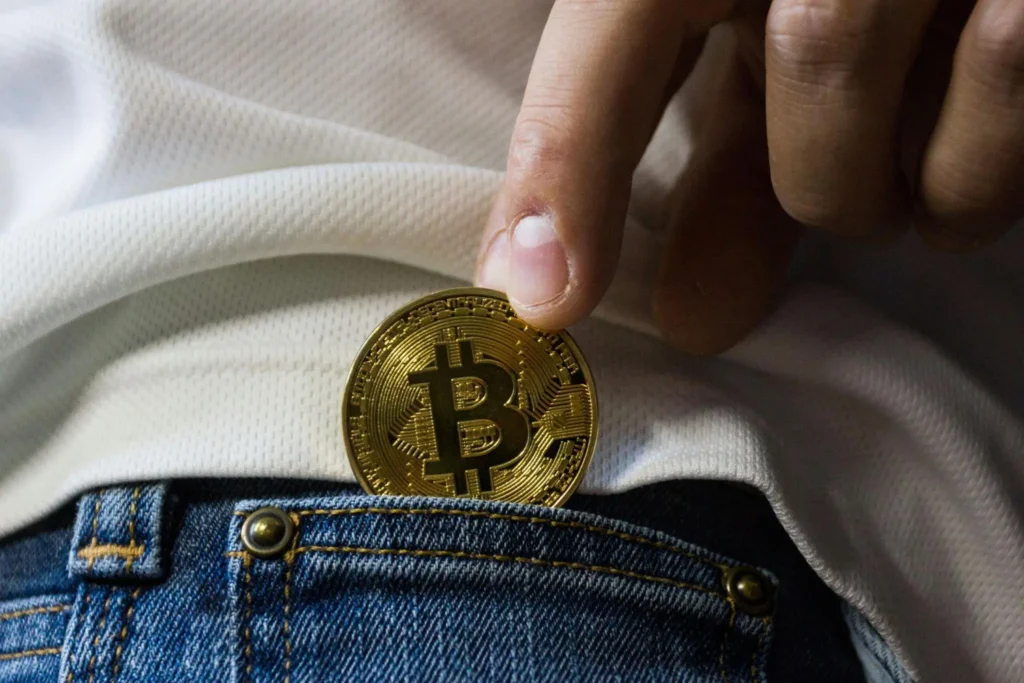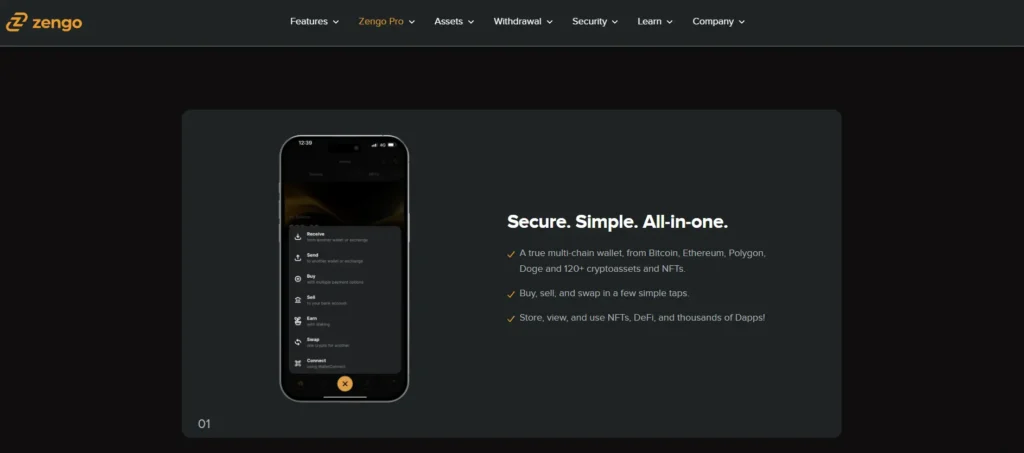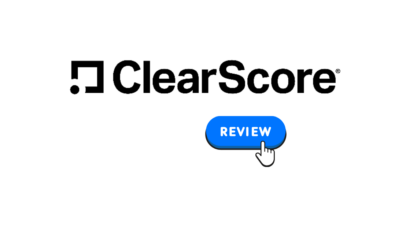Disclosure: Privacy Australia is community-supported. We may earn a commission when you buy a VPN through one of our links. Learn more.
The Ultimate Zengo Wallet Australia Review: Is It the Most Secure Crypto Wallet?
For any trader or investor in the space, keeping your crypto secure is of the utmost importance. And it’s safe to say that if you’re anything like me, you’ve probably invested more time than you’d like into worrying about the safety of your digital assets.

Let’s face it. With all the hacks, scams, and security breaches out there, it’s becoming more and more of the essence to find a solid & secure cryptocurrency wallet.
That’s where Zengo comes in. The Zengo wallet is the self-custodial crypto wallet that’s making waves with its promises of bulletproof security that’s achieved through the use of its multi-party computation (MPC) technology.
In this Zengo wallet review Australia, we’re going to decipher just what sets Zengo apart from the competition.
Throughout this post, we’ll talk about Zengo’s top features, pros, cons, and what others are saying about it. Ready to find out what Zengo is all about? Let’s go!
TL;DR
- Zengo is a non-custodial cryptocurrency wallet that uses innovative multi-party computation (MPC) technology to eliminate the single point of failure associated with traditional wallets.
- It offers a user-friendly interface for managing a diverse range of digital assets, including buying, selling, trading, and connecting to dApps.
- Zengo prioritises security and privacy by distributing parts of your private key across multiple parties, making it virtually impossible for hackers to gain access to your funds.
- While it lacks support for some major cryptocurrencies, Zengo is generally well-received by the community for its advanced security features and ease of use.
- Pricing includes a free “Essentials” version and a paid “Pro” subscription ($9.99/month or $69.99/annually) for additional features like inheritance planning and priority support.
Criteria Breakdown
When you’re choosing a cryptocurrency wallet to keep your funds safe, there’s a few things to keep in mind. In accordance with our Zengo wallet review Australia, let’s break down what makes a cryptocurrency wallet like Zengo worth your time and trust:
- Security: This is non-negotiable. Zengo’s MPC technology and biometric authentication (like facial recognition) make it a fortress for your assets.
- User-Friendliness: You want a wallet that’s easy to use. Zengo’s interface is intuitive, making it perfect for both newbies and seasoned crypto users.
- Supported Assets: Zengo supports over 120 cryptocurrencies, including big names like Bitcoin, Ethereum, and Dogecoin. It’s a true multi-chain wallet.
- Functionality: Beyond storing crypto, Zengo lets you buy, sell, and trade directly within the app. Plus, you can use dApps for DeFi, NFTs, and more.
- Privacy: Zengo is non-custodial, meaning you have full control over your crypto without the need for KYC (Know Your Customer) procedures.
- Reputation and Trust: With over 1,000,000 customers and stellar reviews on app stores, Zengo has earned a solid reputation.
- Cost: Evaluating cost includes not just the price of the wallet but also transaction fees. Zengo offers competitive rates, making it an affordable option.
What is Zengo Wallet?
What It Is Best Known For
For starters, the Zengo isn’t your average wallet. Traditional wallets rely on seed phrases or private keys, while Zengo’s wallet uses multi-party computation (MPC) technology. That means your private key isn’t stored in one place, it’s distributed across multiple parties that include your device and Zengo’s servers. With a setup like this, it’s said to be virtually impossible for hackers to get their hands on your funds.
Additionally, Zengo is highly regarded for its user-friendly interface and feature-rich environment. It supports over 120 cryptocurrencies. These include Bitcoin, Ethereum, and Dogecoin. Zengo lets you manage your portfolio effortlessly. Plus, the wallet also offers built-in exchange capabilities, meaning you can buy, sell, and trade all within the app.

Features
You’ll find that the Zengo wallet is jam-packed with features that are designed to provide smooth and secure cryptocurrencies experience. Here’s some features to take note of:
- Multi-Party Computation (MPC) Technology: Zengo’s innovative use of MPC eliminates the need for seed phrases or private keys, making it a fortress against hacks.
- Biometric Authentication: Advanced options like facial recognition add another layer of security, ensuring only you can access your funds.
- Cryptocurrency Exchange: Buy, sell, and trade over 120 cryptocurrencies directly in the app, including major assets like Bitcoin, Ethereum, and ERC-20 tokens.
- DeFi Integration: Connect to popular dApps like Uniswap and OpenSea to dive into the world of decentralised finance and NFTs.
- Mobile and Desktop Support: Whether you’re on iOS, Android, or desktop, Zengo has got you covered, providing flexibility and convenience.
Pros
Enhanced Security
With Zengo, one of the biggest advantages is its enhanced security measures. The multi-party computation (MPC) technology is leveraged which allows Zengo to eliminate the single point of failure associated with traditional wallets. What’s more, Zengo wallet Australia offers biometric authentication options such as facial recognition for an extra layer of security.
User-Friendly Interface.
Zengo also goes above and beyond to provide a user-friendly interface that’s pretty intuitive. This makes it easily accessible for new and experienced crypto users. The wallet’s sleek design makes it easy to navigate and manage your digital assets, buy, sell, and trade cryptocurrencies, and even connect to DeFi integrations and popular dApps like Uniswap and OpenSea. Regardless of whether you use the mobile app or desktop version, Zengo offers a worthwhile experience that simplifies the complexities that come with managing crypto.
Comprehensive Asset Support
With Zengo wallet Australia, you’ve got support for over 120 cryptocurrencies that include the major players we mentioned earlier (Bitcoin, Ethereum, and Dogecoin). Plus, Zengo supports ERC-20 tokens. You can easily manage your crypto portfolio, buy, sell, and trade a wide range of digital assets, and even connect to popular decentralised apps (dApps) like Uniswap and OpenSea. Truly, this opens up a plethora of opportunities for users to take part in the growing world of decentralised finance (DeFi).
Cons
Limited Asset Support
Per our Zengo review Australia, we uncovered tha while the Zengo wallet does support many cryptocurrencies including major assets and ERC-20 tokens, it’s lacking support for some popular cryptocurrencies like Solana, Cardano, and XRP. For some users, this could be a setback, especially to those who hold a diverse portfolio of digital assets or have special interest in these unsupported cryptocurrencies.
Paid Subscription for Advanced Features
Our Zengo wallet review uncovered that Zengo does offer a free “Essentials” version. However, users must subscribe to the Zengo Pro plan if they wish to access advanced features such as inheritance planning (Legacy Transfer), Web3 Firewall, and priority customer support. The Pro plan is $9.99/month or $69.99 if paid annually. This could be quite the investment for some users, especially those who are just starting out and have a relatively small portfolio. It’s important to evaluate these pro features carefully based on your needs and budget before making the final decision.

Criteria Evaluation
Security: 5/5
It’s inevitable that Zengo’s innovative use of MPC technology for securing private keys is a game-changer in the crypto wallet space.
User-Friendliness: 5/5
Through our Zengo wallet review Australia, we’ve found that this wallet is simple enough to navigate whether you’re using the mobile app or the desktop version.
Supported Assets: 4/5
Zengo wallet currently supports over 120 cryptocurrencies, which gives it a significant edge.
Functionality: 5/5
With the Zengo wallet Australia users can buy, sell, and trade crypto directly within the wallet, eliminating the need for third-party exchanges.
Privacy: 5/5
The Zengo wallet prioritises privacy and anonymity by giving users full control over their private keys.
Reputation and Trust: 4/5
Zengo is committed to transparency and security and has quickly gained a positive reputation among the crypto community.
Cost: 4/5
Within our Zengo wallet review, we’ve learned that Zengo offers a free version of the wallet as well as a pro version. The investment for the paid version can be costly for some.
Community Reviews and Expert Recommendations
For all extensive purposes of this Zengo review Australia, we’ve uncovered that the cryptocurrency community and users of the Zengo app really dig Zengo’s innovative approach to security along with its user-friendly interface. We’ve found that platforms like Trustpilot state that Zengo hase earned the rating of 4.⅖ stars with many users highlighting the Zengo wallet’s advanced security features.
However, other Zengo wallet reviews from users express their concerns about the high fees that are associated with debit/credit card purchase, as well as occasional delays in transaction processing times. Importantly, this isn’t an issue that happens to Zengo alone, as this is very common across the board within the cryptocurrency industry.
We’ve also discovered that experts in the field have recognized Zengo’s potential. Many praise Zengo wallet Australia for its MPC technology and ability to eradicate the single point of failure that as we’ve stated earlier, comes with traditional wallets. Certified, an independent security research firm, has listed Zengo as one of the top three most secure mobile wallets. This has without a doubt, solidified its reputation
Pricing
Zengo wallet offers a flexible pricing model. Whether you’re a casual or more advanced cryptocurrency user, there’s something for everyone. As discussed earlier, there’s the free “Essentials” version and the paid “Zengo Pro” subscription ($9.99/month or $69.99 per year).
Where to Find Zengo Wallet
Zengo wallet is available for download on various platforms. This makes it easy for many users to access it. For mobile users, Zengo can be downloaded from the iOS App Store and the Google Play Store. Desktop users can access Zengo by visiting the official website at https://zengo.com and downloading the desktop application.
Additionally, Zengo may be integrated or partnered with various cryptocurrency exchanges and services. This provides users with the option to connect their Zengo wallet without any hassle for added convenience. Whether you’re buying, selling, or trading, Zengo’s got you covered on multiple fronts.

Alternatives to Zengo Wallet
Although Zengo wallet Australia is super accessible and offers an excellent solution for secure crypto storage and management, it’s important to consider alternative options to make sure you find just what you’re looking for. Here’s some noteworthy alternatives to take a look at:
Exodus
The Exodus wallet supports thousands of assets and allows users to swap over 100 supported digital currencies. With this wallet, you’ve got an option that’s good for new users or those looking to manage their tokens. It offers a wide range of support, including blockchain, fiat on-ramp, and in-app swaps. It’s well known for its design and ease of use along with its built-in exchange.
Trust Wallet
With Trust wallet, users can store and manage over 10 million assets. Trust wallet happens to be the official wallet for Binance and it supports a wide range of cryptocurrencies. It’s good for DeFi and NFTs too.
MetaMask
With the MetaMask wallet, you have a unique feature set that allows users to securely connect to blockchain-based applications and explore decentralised web 3.0. It’s easy-to-use with a wide range of built-in security features that keep your crypto safe. Essentially, if you’re into Ethereum and the world of decentralised finance (DeFi), MetaMask could be of interest to you.
No matter what you decide to do, these wallets all have their own set of strengths too. This makes it worth comparing them to determine if they meet your specific needs and preferences.
FAQs
What is Zengo wallet?
The Zengo wallet is a non-custodial crypto wallet that uses some pretty cutting edge tech that’s called multi-party computation (MPC). This tech keeps your funds much safer than traditional wallets. Traditional wallets required seed phrases or private keys. With Zengo, your private key is spread across your device and secure servers. All-in-all, you’re looking at a setup that makes it near impossible for hackers to get access to your funds (even if they manage to compromise your device).
What cryptocurrencies does Zengo support?
The Zengo wallet is pretty versatile when it comes to the types of crypto it supports. As discussed earlier, Zengo supports major assets like Bitcoin, Ethereum, and Dogecoin. It also supports ERC-20 tokens on the Ethereum and Polygon networks. In total, the Zengo wallet currently supports over 120 different cryptocurrencies and tokens. This allows users to manage their diverse portfolio all within a single wallet.
How secure is Zengo wallet?
From our Zengo wallet review Australia, we’ve determined that the security with Zengo is top-notch. This is thanks to MPC technology, of course. This substantially reduces the risk of hacks. Plus, with features like biometric authentication (facial recognition) and theft protection, you can rest easy knowing that your funds are well-guarded. What’s more, independent security firms have recognized Zengo as one of the top three most secure mobile wallets, which truly says a lot about its reliability.
What is the cost of using Zengo wallet?
Per our Zengo review Australia, we’ve found that Zengo offers both a free and paid version. With the free “Essentials” version, you get access to core features like secure storage, buying, selling, and trading crypto, and dApp integration. For more advanced features, you can subscribe to Zengo Pro ($9.99 per month or $69.99 annually).
Can I use Zengo wallet on my desktop?
Absolutely! The Zengo wallet Australia is available on both mobile and desktop platforms. As discussed within this Zengo review, you can find the mobile apps for iOS and Android devices and you can download the desktop application for Zengo here.Having options like this give users flexibility and convenience in managing their digital assets.
With the desktop version of Zengo, you get the same core features and functionality as the mobile apps. This includes the secure storage, buy, sell, and trade, as well as connection to dApps. With Zengo, users can say hello to consistency across all platforms they choose to use.

Final Thoughts
Security and user-friendliness are paramount considerations when choosing a wallet. Within our Zengo wallet review, we’ve learned that this platform stands out as a compelling solution that seamlessly combines cutting-edge security measures with a sleek and intuitive interface. At Privacy Australia, we believe this makes it a great fit for both novice and experienced crypto-enthusiasts.

Zengo employs multi-party computation technology, solving the problem of the single point of failure occurring in traditional wallets. This branches off portions of the private key among multiple parties for added security. Not to mention, advanced features of the wallet, including biometric authentication and protections against theft, also act to enhance security.
The wallet interface of Zengo is clean, making it easy to use, and pretty self-explanatory in terms of its overall navigation, even for new cryptocurrency users. Simple doesn’t come with the cost of functions here; actually, some nice ones were saved for the advanced user.
Moreover, with continuous improvement and impressions by users, Zengo stays updated regarding security protocols and user needs. The team is also involved with the community in solving issues and adding new features, thereby providing a dedicated, high-quality user experience.
Even though Zengo may not support some of the more popular digital cryptocurrencies, such as Solana, Cardano, and XRP, it does support major assets like Bitcoin, Ethereum, and Dogecoin, in addition to ERC-20 tokens. All of these make this wallet very versatile in managing a diversified portfolio of digital assets. From this point of view, broad compatibility is essential for people aiming to consolidate scattered holdings under the umbrella of a single secure wallet.
Moreover, Zengo is integrated with decentralised applications and supports DeFi platforms; therefore, with respect to the growing blockchain-based services ecosystem, it is very well-positioned. This allows users to interact with DeFi protocols directly from the wallet itself, thereby further increasing ease of use and usability.
To sum up, Zengo wallet is a secure, user-friendly, and feature-rich solution for cryptocurrency storage and management. Its innovative security measures, comprehensive asset support, and flexible pricing make it a strong contender in the cryptocurrency wallet market. While no wallet is perfect, Zengo’s unique approach to security and usability makes it a compelling choice for both casual and advanced cryptocurrency users.
Basically, Zengo is definitely among the better options if you want to use a safe and easy-to-use cryptocurrency wallet. But still, it always pays to look over your specific needs and dig up other options. Online privacy and security are important, so here at Privacy Australia, we have got in-depth reviews and guides regarding the best tools and services that will keep you and your digital assets safe. For more on locking down your online security and privacy, explore our articles on the Best Password Managers and Best Secure Browsers.
You Might Also Like:




